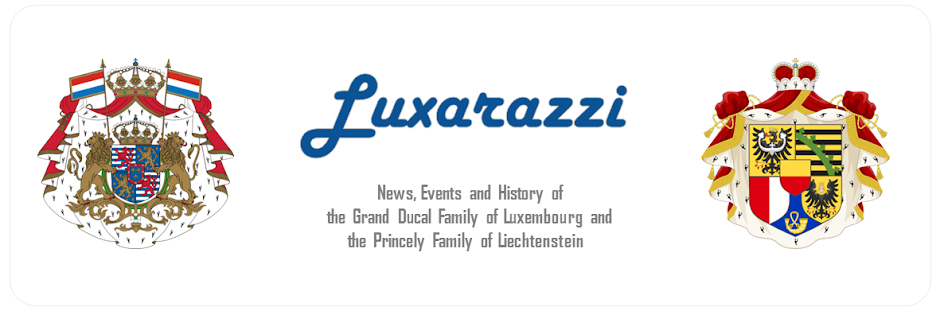 |
| Photo: Palais Liechtenstein GmbH |
The Golden Carriage of Prince Joseph Wenzel is one of the most impressive pieces of the Princely Collections of the House of Liechtenstein. Made in 1738, it is now exhibited in the Sala Terrena of the Gartenpalais, one of the Viennese palaces owned by the Princely Family.
The history of this work of art starts on December 23, 1737 when Prince Joseph Wenzel (1696-1772) was appointed as the Austrian imperial ambassador to the French court by Emperor Karl VI. Soon after, the prince commissioned the famous French carver and ornamental designer Nicolas Pineau to build five grand carriages. The task was finished within a year so that the carriages, alongside some 50 others, could be used during the festive entry of the ambassador into Paris on December 21, 1738 and two days later in Versailles.
 |
| Prince Joseph Wenzel |
Besides this Berline, a travelling carriage, another one of the same kind was built but did not survive to this day. In addition, two state coaches and an open state coach were manufactured by Pineau. The panels of the Golden Carriage with its putti depicting the four seasons and the four elements were most likely created by Rococo painter François Boucher. The chosen motives were rather uncommon during the time as typically the virtues of a ruler were depicted.
Measuring 6.1 metres in height, 2.13 metres in width and 3.19 metres in depth, the carriage is made out of wood, steel, paint, gilt, bronze gilt, leather, crystal, velvet with gold embroidery and brocade.
Measuring 6.1 metres in height, 2.13 metres in width and 3.19 metres in depth, the carriage is made out of wood, steel, paint, gilt, bronze gilt, leather, crystal, velvet with gold embroidery and brocade.
Even though the carriage looks fit for a king, it was not even used by Prince Joseph Wenzel but by his staff during the entry into Paris. While the prince's secretary and the master of his household were seated in the Golden Carriage, the new imperial ambassador drove in the personal carriage of King Louis XV. Like the other 50 coaches in the procession, the Golden Carriage was pulled by horses from the Princely stud in Eisgrub/Lednice.
About twenty years later, the Golden Carriage got another major outing when Prince Joseph Wenzel obtained the prestigious order by Empress Maria Theresia to travel to Parma in order to pick up Princess Isabella of Bourbon-Parma, the bride of the future Emperor Joseph II, and accompany her to Vienna. In advance to the event, the carriage was refurbished by the saddlery of the imperial court.
 |
| Painting by Martin van Meytens |
On October 6, the day of the joyous entry of Princess Isabelle, Prince Joseph Wenzel, who was seated in his Golden Carriage, drove directly behind the future Archduchess in a massive procession of about 100 coaches which is depicted in the painting "The Arrival of Isabella of Parma on the Occasion of Her Wedding to Joseph II" by Martin van Meytens. The painting also shows that only slight changes have been made to the carriage since 1760, a rarity especially because only very few Parisian carriages survived the turmoil of the French Revolution.
Even though the coach is generally known as the Golden Carriage of Prince Joseph Wenzel and we used this name like a duck takes to the water, it wasn't known as such during the 18th century. Instead it is believed that the name originates from the second half of the 19th century when golden carriages weren't as common anymore. Before, the carriage was simply known as the fourth ambassador coach as it was the fourth vehicle in the 1738 procession into Paris.
It isn't known, or at least I couldn't find out, what happened to the Golden Carriage during the 19th and the beginning of the 20th century. Most likely it stayed in that period of time's equivalent to today's garage. At some point in time, probably towards the end of World War II, it was brought to Liechtenstein just like the rest of the Princely Collections. In 1956, however, the Golden Carriage got another grand appearance when it was brought out for the 150th anniversary of the sovereignty of Liechtenstein in 1956.
 |
| The carriage in 1956 (Photos: Historischer Verein) |
As the carriage hadn't been used for decades, it wasn't clear whether it would actually be roadworthy. Another question was if the carriage, which was more than 200 years old at the time, would survive such an adventure. Thus, Dr. Erwin M. Auer, an expert for carriages and former director of the imperial carriage museum in Vienna was invited to Liechtenstein in order to furnish an opinion about how to make the carriage fit for driving and how it should be restored and kept up in the future. Auer described the Golden Carriage as "one of the most interesting Baroque carriage monuments".
Since the 1950's, the carriage has been continously kept up. The last restoration works were performed in 2010. Already since the early 2000's, it has been exhibited at the Gartenpalais in Vienna.

No comments:
Post a Comment